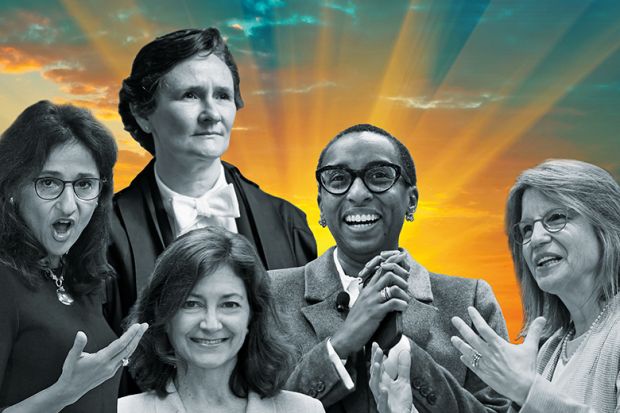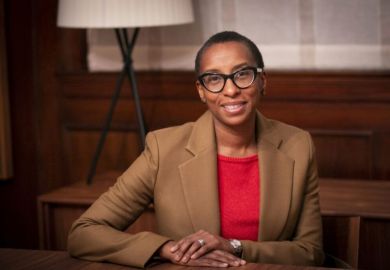A rapid shift towards female leadership in top-tier global universities has been hailed as a turning point that will help encourage more women into senior roles, but the sector has been warned such progress may be frustrated if it is assumed the job is done.
By this summer, four of the five institutions ranked most highly by Times Higher Education will have female leaders: Irene Tracey, who became vice-chancellor of the University of Oxford in January; Claudine Gay, who will take the helm at Harvard University in July; Deborah Prentice, who joins the University of Cambridge that same month; and Sally Kornbluth, who has headed the Massachusetts Institute of Technology since the start of 2023.
Other high-profile hires back up the trend, with London School of Economics director Baroness Shafik named president of Columbia University in January and Linda Mills picked as New York University president last month.
Recent THE analysis found a 41 per cent rise in the number of female heads of institution across the world top 200 over the past five years.
Professor Tracey said there was now a “critical mass” of female candidates for senior roles due to increased access to leadership experience. Forty-two per cent of heads of department at Oxford are now female, up from 14 per cent in 2010, and Professor Tracey said the visibility of women taking on such positions was key to ensuring further progress.
“Psychologically it opens up a sense of what is achievable, if that is the direction of travel you want to go in your career,” she said.
“You can see another living, breathing person doing it and they are maybe combining it with different responsibilities as well. We should not underestimate the power that has.”
Professor Kornbluth, who works alongside a female provost and chancellor at MIT, agreed. She said seeing more women in leadership roles was “exciting, both for the talent and perspective they bring, and because, as role models, they can help broaden the pool of who can imagine themselves in our classrooms and in our laboratories”.
Other female leaders have been at it for much longer. Dame Nancy Rothwell, who will step down as University of Manchester president in 2024 after 14 years in charge, was once the sole female leader of an institution in the UK’s Russell Group. She said that seeing the first female leaders “manage and survive” had led more to follow.
Across the Atlantic, Deborah Buszard, interim president of the University of British Columbia, said the sector had “reached a point where there are very significant numbers of women in the roles that lead people to becoming the leader of an institution”.
“They are deans of faculty, vice-presidents; these are the kinds of roles that are pulling women up. It is a significant moment, but it has not been sudden,” she said.
Professor Buszard said in North America there had been a relaxing of “rigid” tenure track rules after she herself was told she had “shot herself in the foot” by having a baby. Institutions had become more accepting of people’s lives and obligations, she said, which had made a high-level academic career – though still fiercely competitive – more accessible.
Vacancies were now expected to attract a diverse field of candidates, Dame Nancy said, and those that did not were often advertised for again.
Diversity within recruitment panels, unconscious bias training and the traditional job interview format becoming less of a focus have all benefited female candidates, according to Sarah John, managing partner at executive search firm Perrett Laver.
She said this had “dovetailed with a change in the dynamic of leadership in universities”. Whereas once the “heroic style” was prized with one individual leading everything, now there is a recognition that “universities are required to deliver on so many different fronts that no one person can do it”.
This, she believed, both favoured a more participatory approach to leadership – which women often prefer – and has ensured those on the lower rungs of power have been able to gather more experience and expertise to enable them to make the step up more easily.
Despite progress, Ms John said the job was not yet done as the pipeline “was still more of a trickle”. A key barrier remains the increased likelihood of women having caring responsibilities, which can make steps like relocating difficult. The number of ethnic minority leaders also still needs “real attention”, she added.
Mentoring, the creation of networking opportunities and the championing of women to take on roles such as becoming keynote speakers or joining committees will all need to continue, Professor Tracey said.
“I keep encouraging women in leadership roles that it is their responsibility to really champion and identify these opportunities and make sure you are giving others that visibility, getting more women out there and showing the sky does not fall down when we get into leadership roles,” she said.
POSTSCRIPT:
Print headline: Turning point: rapid rise of female leaders
Register to continue
Why register?
- Registration is free and only takes a moment
- Once registered, you can read 3 articles a month
- Sign up for our newsletter
Subscribe
Or subscribe for unlimited access to:
- Unlimited access to news, views, insights & reviews
- Digital editions
- Digital access to THE’s university and college rankings analysis
Already registered or a current subscriber?








